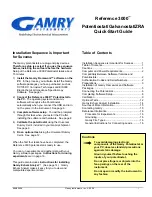
Page 6
BVI 3000 Operator’s Manual
Important Information
Product Description
The BladderScan
®
BVI 3000 is a B-mode ultrasonic instrument, portable
and battery operated, intended for the noninvasive measurement of
urinary bladder volume. A mechanical sector scanning transducer
provides cross-sectional images of the bladder from twelve scan planes.
Based on these images, the BladderScan automatically calculates the
estimated bladder volume in milliliters and displays it on a screen.
Notice to All
Operators
The BladderScan BVI 3000 should be used only by individuals who have
been trained and authorized by a physician or the institution providing
patient care. All operators should read this manual prior to using the BVI
3000. Failure to comply with these instructions may compromise the
performance of the instrument.
Biological Safety
To date, exposure to pulsed diagnostic ultrasound has not been shown
to produce adverse effects. However, ultrasound should be used only
by medical professionals when clinically indicated, using the lowest
exposure times possible commensurate with clinical utility.
The ultrasonic output power of the BladderScan BVI 3000 is not user-
adjustable and is limited to the minimum level necessary for effective
performance. Data on acoustic output levels can be found in the section
titled “Technical Description,” beginning on page 29.
Statement of
Prescription
Caution:
United States Federal law restricts this instrument to use by or
on the order of a physician.
Statement of
Intended Use
The BladderScan BVI 3000 projects ultrasound energy through the lower
abdomen of the nonpregnant patient to obtain an image of the bladder,
which is used to determine bladder volume noninvasively.
Warning:
Not intended for fetal use.
Warning:
Not intended for use on pregnant patients.
Warning:
There is the hazard of possible explosion if the BVI 3000
instrument is used in the presence of flammable anesthetics.
Cautions
The BVI 3000 should not be used on a patient with open skin or wounds
in the suprapubic region.
The patient should not have a catheter in his/her bladder. This could
affect the accuracy of the instrument.
Use care with suprapubic/pelvic surgery patients. Scar tissue, incisions,
sutures and staples affect ultrasound transmission and reflection.
Accuracy may be affected for patients with ascites or free floating fluid
in the peritoneum.







































